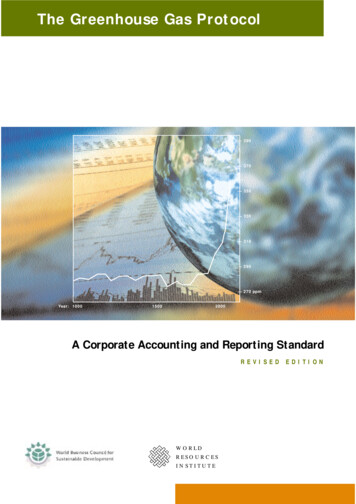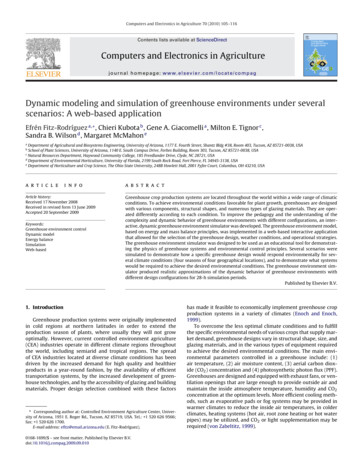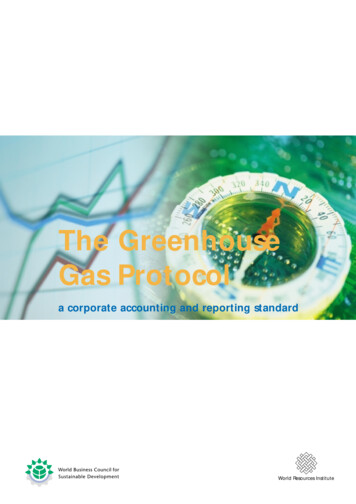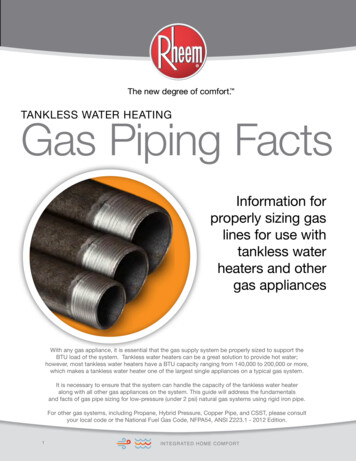
Transcription
The Greenhouse Gas Protocol— 390— 370— 350— 330— 310— 290— 270 ppmYear: 100015002000A Corporate Accounting and Reporting StandardREVISED EDITIONWORLDRESOURCESINSTITUTE
GHG Protocol Initiative TeamJanet RanganathanWorld Resources InstituteLaurent CorbierWorld Business Council for Sustainable DevelopmentPankaj BhatiaWorld Resources InstituteSimon SchmitzWorld Business Council for Sustainable DevelopmentPeter GageWorld Resources InstituteKjell OrenWorld Business Council for Sustainable DevelopmentRevision Working GroupBrian Dawson & Matt SpannagleAustralian Greenhouse OfficeMike McMahonBPPierre BoileauEnvironment CanadaRob FrederickFord Motor CompanyBruno VanderborghtHolcimFraser ThomsonInternational Aluminum InstituteKoichi KitamuraKansai Electric Power CompanyChi Mun Woo & Naseem PankhidaKPMGReid MinerNational Council for Air and Stream ImprovementLaurent SegalenPricewaterhouseCoopersJasper KochShell Global Solutions International B.V.Somnath BhattacharjeeThe Energy Research InstituteCynthia CummisUS Environmental Protection AgencyClare BreidenichUNFCCCRebecca EatonWorld Wildlife FundCore AdvisorsMichael GillenwaterIndependent ExpertMelanie EddisKPMGMarie MarachePricewaterhouseCoopersRoberto AcostaUNFCCCVincent CamobrecoUS Environmental Protection AgencyElizabeth CookWorld Resources Institute
Table of ContentsIntroductionThe Greenhouse Gas Protocol Initiative2Chapter 1GHG Accounting and Reporting PrinciplesST ANDARDChapter 2Business Goals and Inventory DesignGUIDANCEChapter 3Setting Organizational BoundariesST ANDARDGUIDANCE16Chapter 4Setting Operational BoundariesST ANDARDGUIDANCE24Chapter 5Tracking Emissions Over TimeST ANDARDGUIDANCE34Chapter 6Identifying and Calculating GHG EmissionsGUIDANCE40Chapter 7Managing Inventory QualityGUIDANCE48Chapter 8Accounting for GHG ReductionsGUIDANCE58Chapter 9Reporting GHG EmissionsST ANDARDChapter 10Verification of GHG EmissionsGUIDANCE68Chapter 11Setting GHG TargetsGUIDANCE74Appendix AAccounting for Indirect Emissions from Electricity86Appendix BAccounting for Sequestered Atmospheric Carbon88Appendix COverview of GHG Programs90Appendix DIndustry Sectors and eferences103Contributors104
IntroductionThe Greenhouse Gas Protocol Initiative is a multi-stakeholder partnership ofbusinesses, non-governmental organizations (NGOs), governments, and othersconvened by the World Resources Institute (WRI), a U.S.-based environmentalNGO, and the World Business Council for Sustainable Development (WBCSD), aGeneva-based coalition of 170 international companies. Launched in 1998, theInitiative’s mission is to develop internationally accepted greenhouse gas (GHG)accounting and reporting standards for business and to promote their broad adoption.The GHG Protocol Initiative comprises two separate but linked standards: GHG Protocol Corporate Accounting and Reporting Standard (this document, whichprovides a step-by-step guide for companies to use in quantifying and reporting theirGHG emissions) GHG Protocol Project Quantification Standard (forthcoming; a guide for quantifyingreductions from GHG mitigation projects)2
INTRODUCTIONThe first edition of the GHG Protocol Corporate Accounting andReporting Standard (GHG Protocol Corporate Standard), published inSeptember 2001, enjoyed broad adoption and acceptance around theglobe by businesses, NGOs, and governments. Many industry, NGO,and government GHG programs1 used the standard as a basis fortheir accounting and reporting systems. Industry groups, suchas the International Aluminum Institute, the International Councilof Forest and Paper Associations, and the WBCSD CementSustainability Initiative, partnered with the GHG Protocol Initiativeto develop complementary industry-specific calculation tools.Widespread adoption of the standard can be attributed to the inclusion of many stakeholders in its development and to the fact thatit is robust, practical, and builds on the experience and expertise ofnumerous experts and practitioners.The business value of a GHG inventoryThis revised edition of the GHG Protocol Corporate Standard is theculmination of a two-year multi-stakeholder dialogue, designedto build on experience gained from using the first edition. It includesadditional guidance, case studies, appendices, and a new chapteron setting a GHG target. For the most part, however, the first editionof the Corporate Standard has stood the test of time, and thechanges in this revised edition will not affect the results of mostGHG inventories. Public reporting and participation in voluntary GHG programsThis GHG Protocol Corporate Standard provides standards andguidance for companies and other types of organizations2preparing a GHG emissions inventory. It covers the accountingand reporting of the six greenhouse gases covered by the KyotoProtocol — carbon dioxide (CO2), methane (CH4 ), nitrous oxide(N2O), hydrofluorocarbons (HFCs), perfluorocarbons (PFCs),and sulphur hexafluoride (SF6). The standard and guidance weredesigned with the following objectives in mind:This standard is written primarily from the perspective of a business developing a GHG inventory. However, it applies equally toother types of organizations with operations that give rise to GHGemissions, e.g., NGOs, government agencies, and universities.3It should not be used to quantify the reductions associated withGHG mitigation projects for use as offsets or credits—theforthcoming GHG Protocol Project Quantification Standard willprovide standards and guidance for this purpose. To help companies prepare a GHG inventory that representsa true and fair account of their emissions, through the use ofstandardized approaches and principlesPolicy makers and architects of GHG programs can also use relevant parts of this standard as a basis for their own accountingand reporting requirements. To simplify and reduce the costs of compiling a GHG inventory To provide business with information that can be used to buildan effective strategy to manage and reduce GHG emissions To provide information that facilitates participation in voluntaryand mandatory GHG programs To increase consistency and transparency in GHG accountingand reporting among various companies and GHG programs.Both business and other stakeholders benefit from convergingon a common standard. For business, it reduces costs if their GHGinventory is capable of meeting different internal and externalinformation requirements. For others, it improves the consistency,transparency, and understandability of reported information,making it easier to track and compare progress over time.Global warming and climate change have come to the fore as akey sustainable development issue. Many governments are takingsteps to reduce GHG emissions through national policies thatinclude the introduction of emissions trading programs, voluntaryprograms, carbon or energy taxes, and regulations and standardson energy efficiency and emissions. As a result, companies mustbe able to understand and manage their GHG risks if they are toensure long-term success in a competitive business environment,and to be prepared for future national or regional climate policies.A well-designed and maintained corporate GHG inventory canserve several business goals, including: Managing GHG risks and identifying reduction opportunities Participating in mandatory reporting programs Participating in GHG markets Recognition for early voluntary action.Who should use this standard?3
IntroductionRelationship to other GHG programsGHG calculation toolsIt is important to distinguish between the GHG Protocol Initiativeand other GHG programs. The GHG Protocol Corporate Standardfocuses only on the accounting and reporting of emissions. It doesnot require emissions information to be reported to WRI or WBCSD.In addition, while this standard is designed to develop a verifiableinventory, it does not provide a standard for how the verificationprocess should be conducted.To complement the standard and guidance provided here,a number of cross-sector and sector-specific calculation toolsare available on the GHG Protocol Initiative website(www.ghgprotocol.org), including a guide for small office-basedorganizations (see chapter 6 for full list). These tools provide stepby-step guidance and electronic worksheets to help userscalculate GHG emissions from specific sources or industries. Thetools are consistent with those proposed by the IntergovernmentalPanel on Climate Change (IPCC) for compilation of emissionsat the national level (IPCC, 1996). They have been refined to beuser-friendly for non-technical company staff and to increase theaccuracy of emissions data at a company level. Thanks to helpfrom many companies, organizations, and individual expertsthrough an intensive review of the tools, they are believed torepresent current “best practice.”The GHG Protocol Corporate Standard has been designed to beprogram or policy neutral. However, many existing GHG programsuse it for their own accounting and reporting requirements and itis compatible with most of them, including: Voluntary GHG reduction programs, e.g., the World Wildlife Fund(WWF) Climate Savers, the U.S. Environmental ProtectionAgency (EPA) Climate Leaders, the Climate Neutral Network,and the Business Leaders Initiative on Climate Change (BLICC) GHG registries, e.g., California Climate Action Registry (CCAR),World Economic Forum Global GHG RegistryReporting in accordance with theGHG Protocol Corporate Standard National and regional industry initiatives, e.g., New ZealandBusiness Council for Sustainable Development, Taiwan BusinessCouncil for Sustainable Development, Association des entreprisespour la réduction des gaz à effet de serre (AERES)The GHG Protocol Initiative encourages the use of the GHG ProtocolCorporate Standard by all companies regardless of their experiencein preparing a GHG inventory. The term “shall” is used in thechapters containing standards to clarify what is required to prepareand report a GHG inventory in accordance with the GHG ProtocolCorporate Standard. This is intended to improve the consistencywith which the standard is applied and the resulting informationthat is publicly reported, without departing from the initial intent ofthe first edition. It also has the advantage of providing a verifiablestandard for companies interested in taking this additional step. GHG trading programs,4 e.g., UK Emissions Trading Scheme (UKETS), Chicago Climate Exchange (CCX), and the European UnionGreenhouse Gas Emissions Allowance Trading Scheme (EU ETS) Sector-specific protocols developed by a number of industry associations, e.g., International Aluminum Institute, InternationalCouncil of Forest and Paper Associations, International Iron andSteel Institute, the WBCSD Cement Sustainability Initiative, andthe International Petroleum Industry Environmental ConservationAssociation (IPIECA).Since GHG programs often have specific accounting and reportingrequirements, companies should always check with any relevantprograms for any additional requirements before developingtheir inventory.4INTRODUCTIONOverview of main changes to the first editionThis revised edition contains additional guidance, case studies,and annexes. A new guidance chapter on setting GHG targetshas been added in response to many requests from companiesthat, having developed an inventory, wanted to take thenext step of setting a target. Appendices have been added onaccounting for indirect emissions from electricity and onaccounting for sequestered atmospheric carbon.
5INTRODUCTIONChanges to specific chapters include: C H A P T E R 1 : Minor rewording of principles. C H A P T E R 2 : Goal-related information on operational boundaries has been updated and consolidated. C H A P T E R 3 : Although still encouraged to account foremissions using both the equity and controlapproaches, companies may now report usingone approach. This change reflects the factthat not all companies need both types of information to achieve their business goals. Newguidance has been provided on establishingcontrol. The minimum equity threshold forreporting purposes has been removed to enableemissions to be reported when significant. CHAPTER 4:The definition of scope 2 has been revised toexclude emissions from electricity purchasedfor resale—these are now included in scope 3.This prevents two or more companies fromdouble counting the same emissions in thesame scope. New guidance has been added onaccounting for GHG emissions associated withelectricity transmission and distribution losses.Additional guidance provided on Scope 3categories and leasing. C H A P T E R 5 : The recommendation of pro-rata adjustmentswas deleted to avoid the need for two adjustments. More guidance has been added onadjusting base year emissions for changes incalculation methodologies. CHAPTER 6:The guidance on choosing emission factorshas been improved. C H A P T E R 7 : The guidance on establishing an inventoryquality management system and on the applications and limitations of uncertainty assessmenthas been expanded. C H A P T E R 8 : Guidance has been added on accounting forand reporting project reductions and offsets inorder to clarify the relationship between theGHG Protocol Corporate and Project Standards.Frequently asked questions Below is a list of frequently asked questions, with directions to therelevant chapters. What should I consider when setting out toaccount for and report emissions?CHAPTER 2 How do I deal with complex company structuresand shared ownership?CHAPTER 3 What is the difference between direct and indirectemissions and what is their relevance?CHAPTER 4 Which indirect emissions should I report?CHAPTER 4 How do I account for and report outsourced andleased operations?CHAPTER 4 What is a base year and why do I need one?CHAPTER 5 My emissions change with acquisitions anddivestitures. How do I account for these?CHAPTER 5 How do I identify my company’s emission sources? C H A P T E R 6 What kinds of tools are there to help mecalculate emissions? What data collection activities and data managementissues do my facilities have to deal with?CHAPTER 6 What determines the quality and credibility of myemissions information?CHAPTER 7 How should I account for and report GHG offsetsthat I sell or purchase?CHAPTER 8 What information should be included in a GHGpublic emissions report?CHAPTER 9 What data must be available to obtain externalverification of the inventory data?C H A P T E R 10 What is involved in setting an emissions target andhow do I report performance in relation to my target? C H A P T E R 11NOTES1GHG program is a generic term used to refer to any voluntary or mandatoryinternational, national, sub-national government or non-governmentalauthority that registers, certifies, or regulates GHG emissions or removals.2Throughout the rest of this document, the term “company” or “business” is used as shorthand for companies, businesses and other typesof organizations.3For example, WRI uses the GHG Protocol Corporate Standard to publiclyreport its own emissions on an annual basis and to participate in theChicago Climate Exchange.4Trading programs that operate at the level of facilities primarily use theGHG Protocol Initiative calculation tools. C H A P T E R 9 : The required and optional reporting categorieshave been clarified. C H A P T E R 1 0 : Guidance on the concepts of materiality andmaterial discrepancy has been expanded. C H A P T E R 1 1 : New chapter added on steps in setting a targetand tracking and reporting progress.CHAPTER 6
1STANDARDGHG Accounting and Reporting PrinciplesAs with financial accounting and reporting, generally accepted GHGaccounting principles are intended to underpin and guide GHGaccounting and reporting to ensure that the reported information represents afaithful, true, and fair account of a company’s GHG emissions.S T A N D A R DG U I D A N C E6
CHAPTER 1:GHG Accounting and Reporting Principles7GHG accounting and reporting practices are evolving and are new to manybusinesses; however, the principles listed below are derived in part fromgenerally accepted financial accounting and reporting principles. They alsoreflect the outcome of a collaborative process involving stakeholders froma wide range of technical, environmental, and accounting disciplines.GHG accounting and reporting shall be based on the following principles:Ensure the GHG inventory appropriately reflects the GHG emissions of the company andserves the decision-making needs of users – both internal and external to the company.COMPLETENESSAccount for and report on all GHG emission sources and activities within the choseninventory boundary. Disclose and justify any specific exclusions.CONSISTENCYUse consistent methodologies to allow for meaningful comparisons of emissions over time.Transparently document any changes to the data, inventory boundary, methods, or any otherrelevant factors in the time series.TRANSPARENCYAddress all relevant issues in a factual and coherent manner, based on a clear audit trail.Disclose any relevant assumptions and make appropriate references to the accounting andcalculation methodologies and data sources used.ACCURACYEnsure that the quantification of GHG emissions is systematically neither over nor underactual emissions, as far as can be judged, and that uncertainties are reduced as far aspracticable. Achieve sufficient accuracy to enable users to make decisions with reasonableassurance as to the integrity of the reported information.SR E L E VA N C ETANDARD
hese principles are intended to underpin all aspectsof GHG accounting and reporting. Their applicationwill ensure that the GHG inventory constitutes a trueand fair representation of the company’s GHG emissions.Their primary function is to guide the implementation ofthe GHG Protocol Corporate Standard, particularly whenthe application of the standards to specific issues or situations is ambiguous.Tbias in estimates (i.e., an underestimate). Although itappears useful in theory, the practical implementation ofsuch a threshold is not compatible with the completenessprinciple of the GHG Protocol Corporate Standard. In orderto utilize a materiality specification, the emissionsfrom a particular source or activity would have to bequantified to ensure they were under the threshold.However, once emissions are quantified, most of thebenefit of having a threshold is lost.RelevanceA threshold is often used to determine whether an erroror omission is a material discrepancy or not. This isnot the same as a de minimis for defining a completeinventory. Instead companies need to make a good faitheffort to provide a complete, accurate, and consistentaccounting of their GHG emissions. For cases whereemissions have not been estimated, or estimated at aninsufficient level of quality, it is important that this istransparently documented and justified. Verifiers candetermine the potential impact and relevance of the exclusion, or lack of quality, on the overall inventory report.DANCEGHG Accounting and Reporting PrinciplesGUIFor an organization’s GHG report to be relevant meansthat it contains the information that users —bothinternal and external to the company—need for theirdecision making. An important aspect of relevance is theselection of an appropriate inventory boundary thatreflects the substance and economic reality of thecompany’s business relationships, not merely its legalform. The choice of the inventory boundary is dependenton the characteristics of the company, the intendedpurpose of information, and the needs of the users. Whenchoosing the inventory boundary, a number of factorsshould be considered, such as: Organizational structures: control (operationaland financial), ownership, legal agreements, jointventures, etc. Operational boundaries: on-site and off-site activities,processes, services, and impacts Business context: nature of activities, geographic locations, industry sector(s), purposes of information, andusers of informationMore information on defining an appropriate inventoryboundary is provided in chapters 2, 3, and 4.CompletenessAll relevant emissions sources within the choseninventory boundary need to be accounted for so that acomprehensive and meaningful inventory is compiled.In practice, a lack of data or the cost of gatheringdata may be a limiting factor. Sometimes it istempting to define a minimum emissions accountingthreshold (often referred to as a materiality threshold)stating that a source not exceeding a certain sizecan be omitted from the inventory. Technically, such athreshold is simply a predefined and accepted negative8CHAPTER 1More information on completeness is provided in chapters 7 and 10.ConsistencyUsers of GHG information will want to track andcompare GHG emissions information over time in orderto identify trends and to assess the performance ofthe reporting company. The consistent application ofaccounting approaches, inventory boundary, and calculation methodologies is essential to producing comparableGHG emissions data over time. The GHG informationfor all operations within an organization’s inventoryboundary needs to be compiled in a manner that ensuresthat the aggregate information is internally consistentand comparable over time. If there are changes in theinventory boundary, methods, data or any other factorsaffecting emission estimates, they need to be transparently documented and justified.More information on consistency is provided inchapters 5 and 9.
CHAPTER 1Volkswagen:Maintaining completeness over timeVolkswagen is a global auto manufacturer and the largestautomaker in Europe. While working on its GHG inventory,Volkswagen realized that the structure of its emission sources hadundergone considerable changes over the last seven years.Emissions from production processes, which were considered to beirrelevant at a corporate level in 1996, today constitute almost20 percent of aggregated GHG emissions at the relevant plantsites. Examples of growing emissions sources are new sites forengine testing or the investment into magnesium die-castingequipment at certain production sites. This example shows thatemissions sources have to be regularly re-assessed to maintain acomplete inventory over time.GHG Accounting and Reporting Principles9AccuracyData should be sufficiently precise to enable intendedusers to make decisions with reasonable assurance thatthe reported information is credible. GHG measurements, estimates, or calculations should be systemicallyneither over nor under the actual emissions value, as faras can be judged, and that uncertainties are reduced asfar as practicable. The quantification process should beconducted in a manner that minimizes uncertainty.Reporting on measures taken to ensure accuracy in theaccounting of emissions can help promote credibilitywhile enhancing transparency.More information on accuracy is provided in chapter 7.TransparencyDANCEThe Body Shop, with help from the Business Leaders Initiative onClimate Change (BLICC) program, approached this problem witha two-tiered solution. First, stores were encouraged to activelypursue direct consumption data through disaggregated data ordirect monitoring. Second, if unable to obtain direct consumptiondata, stores were given standardized guidelines for estimatingemissions based on factors such as square footage, equipmenttype, and usage hours. This system replaced the prior fragmentaryapproach, provided greater accuracy, and provided a morecomplete account of emissions by including facilities that previously were unable to calculate emissions. If such limitations inthe measurement processes are made transparent, users of theinformation will understand the basis of the data and the trade off that has taken place.IAs an international, values-driven retailer of skin, hair, body care,and make-up products, the Body Shop operates nearly 2,000 locations, serving 51 countries in 29 languages. Achieving bothaccuracy and completeness in the GHG inventory process for sucha large, disaggregated organization, is a challenge. Unavailabledata and costly measurement processes present significantobstacles to improving emission data accuracy. For example, it isdifficult to disaggregate energy consumption information forshops located within shopping centers. Estimates for these shopsare often inaccurate, but excluding sources due to inaccuracycreates an incomplete inventory.UMore information on transparency is provided in chapters 9 and 10.The Body Shop: Solving the trade-offbetween accuracy and completenessGTransparency relates to the degree to which informationon the processes, procedures, assumptions, and limitations of the GHG inventory are disclosed in a clear,factual, neutral, and understandable manner based onclear documentation and archives (i.e., an audit trail).Information needs to be recorded, compiled, andanalyzed in a way that enables internal reviewers andexternal verifiers to attest to its credibility. Specificexclusions or inclusions need to be clearly identified andjustified, assumptions disclosed, and appropriate references provided for the methodologies applied and thedata sources used. The information should be sufficientto enable a third party to derive the same results ifprovided with the same source data. A “transparent”report will provide a clear understanding of the issues inthe context of the reporting company and a meaningfulassessment of performance. An independent externalverification is a good way of ensuring transparency anddetermining that an appropriate audit trail has beenestablished and documentation provided.
Business Goals and Inventory DesignGUIDANCE2Improving your understanding of your company’s GHG emissions by compilinga GHG inventory makes good business sense. Companies frequently cite thefollowing five business goals as reasons for compiling a GHG inventory: Managing GHG risks and identifying reduction opportunities Public reporting and participation in voluntary GHG programs Participating in mandatory reporting programs Participating in GHG markets Recognition for early voluntary actionG U I D A N C E10
CHAPTER 2Companies generally want their GHG inventory to becapable of serving multiple goals. It therefore makessense to design the process from the outset to provideinformation for a variety of different users anduses—both current and future. The GHG ProtocolCorporate Standard has been designed as a comprehensiveGHG accounting and reporting framework to providethe information building blocks capable of serving mostbusiness goals (see Box 1). Thus the inventory datacollected according to the GHG Protocol CorporateStandard can be aggregated and disaggregated forvarious organizational and operational boundaries andfor different business geographic scales (state, country,Annex 1 countries, non-Annex 1 countries, facility,business unit, company, etc.).BOX 1.Business goals served by GHG inventoriesManaging GHG risks and identifying reduction opportunities Identifying risks associated with GHG constraints in the future Identifying cost effective reduction opportunities Setting GHG targets, measuring and reporting progress Reporting to government and NGO reporting programs,including GHG registries Calculating carbon/GHG taxesOn a more positive note, what gets measured getsmanaged. Accounting for emissions can help identifythe most effective reduction opportunities. This candrive increased materials and energy efficiency as wellas the development of new products and services thatreduce the GHG impacts of customers or suppliers. Thisin turn can reduce production costs and help differentiate the company in an increasingly environmentallyconscious marketplace. Conducting a rigorous GHGinventory is also a prerequisite for setting an internalor public GHG target and for subsequently measuringand reporting progress.NCRecognition for early voluntary action Providing information to support “baseline protection” and/orcredit for early actionIn the context of future GHG regulations, significantGHG emissions in a company’s value chain may result inincreased costs (upstream) or reduced sales (downstream), even if the company itself is not directly subjectto regulations. Thus investors may view significant indirect emissions upstream or downstream of a company’soperations as potential liabilities that need to bemanaged and reduced. A limited focus on direct emissions from a company’s own operations may miss majorGHG risks and opportunities, while leading to a misinterpretation of the company’s actual GHG exposure.A Participating in external cap and trade allowance trading programsCompiling a comprehensive GHG inventory improvesa company’s understanding of its emissions profileand any potential GHG liability or “exposure.” Acompany’s GHG exposure is increasingly becoming amanagement issue in light of heightened scrutiny by theinsurance industry, shareholders, and the emergence ofenvironmental regulations/policies designed to reduceGHG emissions.DParticipating in GHG markets Supporting internal GHG trading programsManaging GHG risksand identifying reduction opportunitiesIParticipating in mandatory reporting programs Participating in government reporting programs at the national,regional, or local levelAppendix C provides an overview of various GHGprograms—many of which are based on the GHG ProtocolCorporate Standard. The guidance sections of chapters 3and 4 provide additional information on how to designan inventory for different goals and uses.U Eco-labelling and GHG certification11GPublic reporting and participation in voluntary GHG programs Voluntary stakeholder reporting of GHG emissions and progresstowards GHG targetsBusiness Goals and Inventory DesignE
EBusiness Goals and Inventory DesignCIBM: The role of renewable energyin reducing GHG emissionsUIDANIndirect emissions associated with the consum
A Corporate Accounting and Reporting Standard REVISED EDITION The Greenhouse Gas Protocol — 390 — 370 — 350 — 330 — 310 — 290 — 270 ppm Year: 1000 1500 2000










